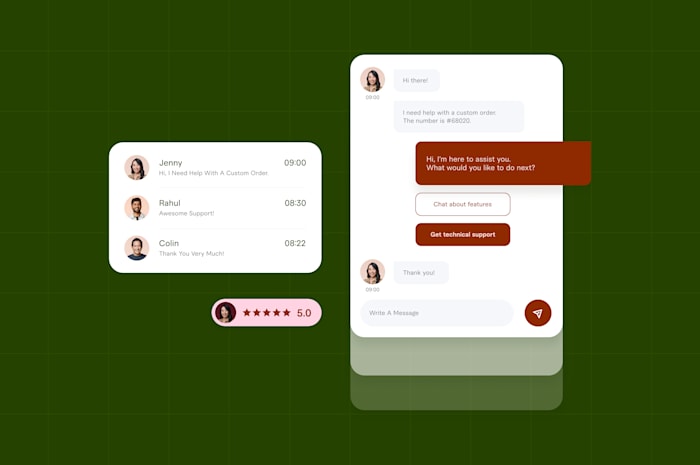What Are Ecommerce Chatbots & Why You Should Invest in Them in 2024?
Ready to take your small business to the next level? Explore the benefits of chatbots and learn more about their use cases for ecommerce stores.
 October 7, 2023
October 7, 2023 9 minute reading
9 minute reading
From 24/7 customer service to personalized recommendations, customers these days have a higher degree of expectations. In part, we'll have to credit the improvements in technology for this change in consumer behavior.
And the technology that played the most pivotal role in that? Ecommerce chatbots.
In 2022, 88% of customers have had at least one conversation with a chatbot. Moreover, 74% of business owners were also satisfied with deploying such a bot on their website.
These chatbots offer genuine value for companies who want to improve the customer experience and conversion rates. But what exactly are these bots, and how can you leverage them?
In this guide, we'll explore why you should consider investing in them, popular use cases, and examples of the best ecommerce chatbots.
Hire an expert chatbot developer on Fiverr
What are ecommerce chatbots?
Ecommerce chatbots are deployed on ecommerce websites to improve the online store experience. They're programmed to interact with customers through conversational interfaces, forming a crucial part of the customer support department.
These chatbots are of two types: rule-based and AI chatbots. Rule-based chatbots function based on predefined rules and you can design conversation flows based on these rules. For example, answer product questions or frequently asked questions.
Artificial intelligence (AI) powered chatbots, also known as conversational AI chatbots use machine learning algorithms to provide better answers based on historical input.
For example, if you want to know which products are in stock or have questions about your order status, these questions are best suited for this bot.

Alt text: A graphic representation of the differences between rule-based and AI chatbots
Why should you invest in ecommerce chatbots?
Here are a few benefits of using chatbots for your ecommerce business:
You want to offer a seamless customer experience
You can hire only so many customer support agents to handle the high volume of tickets. Even when you don't have a high volume, the nature of heavy requests or repetitive requests can burden your support teams. This leads to more errors and missed tickets—leading to a bad customer experience.
With chatbots, that’s not the case anymore. It automates part of the process, leaving your human agents time to handle more complex requests that need a human touch.
This is why, in 2023, online shoppers and ecommerce companies will save over 2.5 billion hours in customer service. Customers can expect instant response rates and a live agent to help when needed.
You want to gather more customer data
Unless you know your customers well, it's challenging to refine your business processes to cater to them. Using chatbots, you can collect customer data like their feedback, purchasing patterns, preferences, demographics, and browsing patterns.
“Initially, our customer-service agents were handling these tasks, but the results were inconsistent,” says Keith Gregory, chief revenue and financial officer at Highland Laboratories Inc., a wellness product manufacturer. “We brought in a chatbot, developed by a specialized agency, to automate this process.”
“They programmed the chatbot to analyze customer behavior and purchase history. When a customer added a product to their cart, the chatbot would suggest complementary items or upgrades, effectively acting as a virtual sales assistant. The results were remarkable. Within the first month, we saw a 25% increase in average order value and a 15% uptick in customer satisfaction ratings.”
For example, you can provide specific prompts asking customers what kind of products they want to purchase. Over time, you can collate that data and stock up your inventory accordingly.
You want to automate the sales process
Efficiency is key for any business—and automation plays a huge role. Instead of having live agents recommend products or expecting customers to find products themselves, use a chatbot solution to automate that process.
Twenty-seven percent of customers say that functionality like chatbots influences their purchasing decisions. Using conversational commerce, you can guide customers through the customer journey, from choosing products to offering a better checkout experience. This enables you to allocate resources where they're the most effective.
You want to expand your sales channels
You must meet your customers where they're present, and your website is not always the answer. For example, if a customer lands on your Facebook page, that's an opportunity to engage them. So, if you integrate a chatbot to provide more information about your catalog, you can do it right there.
This omnichannel presence lets you increase sales and provides customers with the convenience they have come to expect in modern retail.
You want to capture more leads from your channels
You can use chatbots for lead generation by engaging potential customers directly on your website or other channels like social media. Yoana Wong, co-founder of Secret Florists, a floral boutique, recommends using gamification elements to achieve that.
“Implementing chatbots with gamification elements, such as quizzes, challenges, or rewards, can enhance customer engagement and create a more interactive online shopping experience,” says Wong. “Customers can be encouraged to participate in activities that not only entertain but also educate them about products.”
“For example, a cosmetic e-commerce store could have a chatbot that offers a ‘Virtual Beauty Quiz’ to customers, where they answer questions related to their preferences and receive personalized product recommendations as a result.”
Then, feed these leads directly into your customer relationship management (CRM) system. This enables immediate follow-up actions, whether an email, a special offer, or a phone call from your sales team.
You can collect more reviews on autopilot
Offering social proof right when the customer is making a purchase can influence their decision. However, gathering reviews requires manual follow-up, resulting in wasted time and effort, as you can lose out on testimonials when you don't. So, automate this process.
“We use a chatbot to collect customer reviews, and that has helped us convert every purchase order into an authentic review from our customers,” says Will Baker, director of Skirtings R Us, a skirting board & architrave store.
“These reviews are then shared automatically across our website and social media handles. Using this chatbot has helped us put together hundreds of genuine and positive customer reviews, which has immediately boosted the brand's trust and reliability, making it easier to convert incoming leads.”
You can reduce abandoned cart rates
Research from the Baymard Institute shows that 70% of shoppers abandon their carts. And the top three reasons why that happens is because of:
High costs like shipping, tax, or fees
Requiring the customer to create an account
Slow delivery times for products
This leads to a substantial loss in revenue, but you can combat this issue using chatbots. You can reach out to the customer with a chatbot pop-up, asking them what's stopping them from shopping from you. It allows you to address issues in real time and reduce cart abandonment rates.
Use cases of ecommerce chatbots
Chatbots offer many capabilities, and many companies have gotten creative with them. A simple widget on your website can drive thousands of dollars in sales each year.
Here are the most popular use cases for them:
1. Product suggestions
Customers want to know about your products—but providing an entire catalog makes it difficult to go through it. And your search bar might not bring up the right products either.
One way to solve this problem is by adding a section for offering product recommendations within your bot. Based on your customer's responses, it can provide a specific set of products, and you can tailor this based on aspects like:
The customer’s search history
Most searched ecommerce products
Best selling products
You can even offer options to upsell products and drive sales for specific products.
With AI-powered chatbots, its suggestions can become even more accurate as the customers keep conversing with them. For example, Invigor8, a health supplements company, asks pointed questions about your health concerns and serves up personalized recommendations based on that.

Alt text: Invigor8’s ecommerce chatbot
2. Lead capture
While traditional forms and pop-ups help with email capture, occasionally, customers might accidentally click away or find the form too long to fill. Instead, you can use a lead capture bot to capture email addresses for promotional or lead-nurturing emails.
You can also qualify the leads using targeted questions like type of company if you're serving other businesses. You can send this data directly to your CRM, turning casual browsers into prospective customers.
For example, Graza, an online retailer of olive oil, immediately asks for the customer's email address when they ask about their products. This lets them capture email addresses within the website without intrusive pop-ups or account creation.
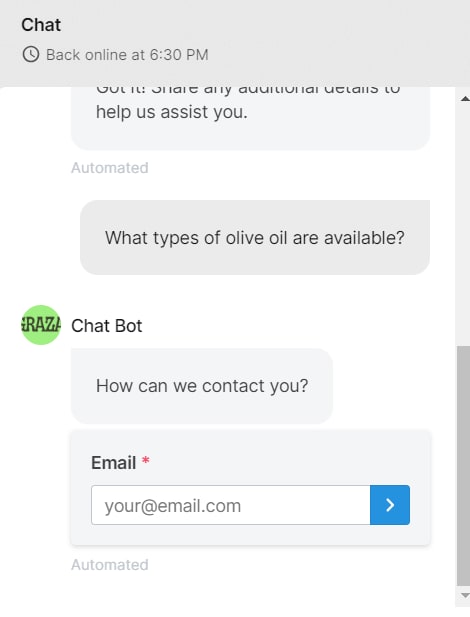
Alt text: Graza’s ecommerce chatbot
3. Customer service
From answering questions about shipping and returns to providing information on how to use a product, chatbots offer 24/7 assistance. Their uninterrupted availability is excellent for online businesses with a global audience across time zones.
Kith, a clothing and accessories store, uses a chatbot to offer constant customer support. For example, when we asked a customer query like “I need help tracking my order,” it immediately offered a support article that discusses it in detail.
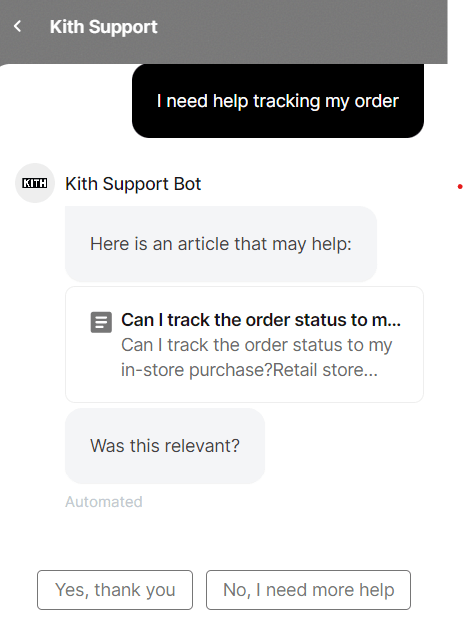
Alt text: Kith’s ecommerce support bot
4. Post sales service
Your chatbot's job doesn't end when customers shop from you. Instead, you can extend its functionality to offer post-sales support too. You can do it for the following:
Order tracking
Return facilitation
Warranty information
Returns and refunds
Reporting damaged products
Chomps, a meat sticks company, immediately offers resolution through its support bot. When we mentioned that our order didn't arrive, the bot gave information like the period after which to report it and in what scenarios to seek help. This reduces the number of unnecessary tickets down the line.
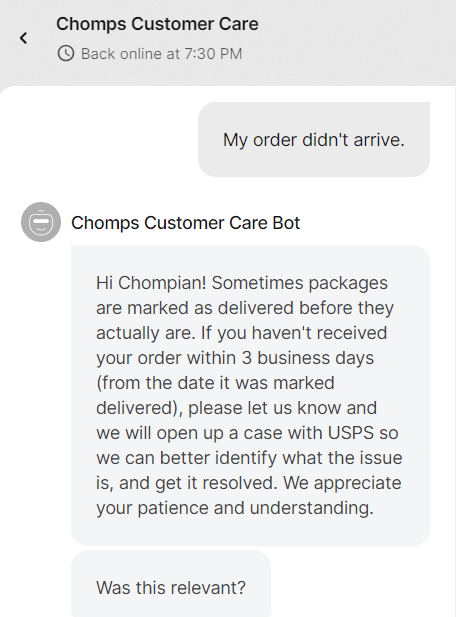
Alt text: Chomp’s customer care bot
5. FAQ chatbots
Too often, support teams are burdened with the same type of questions. To resolve that, you can program your bot to list the most popular questions with answers for each.
In the example below, David's Tea offers a set of resources from its knowledge base through its chatbot. It also includes the option to look at common queries or talk to a live agent if that's what you prefer. Offering multiple options also makes the customer feel in control of the interaction.
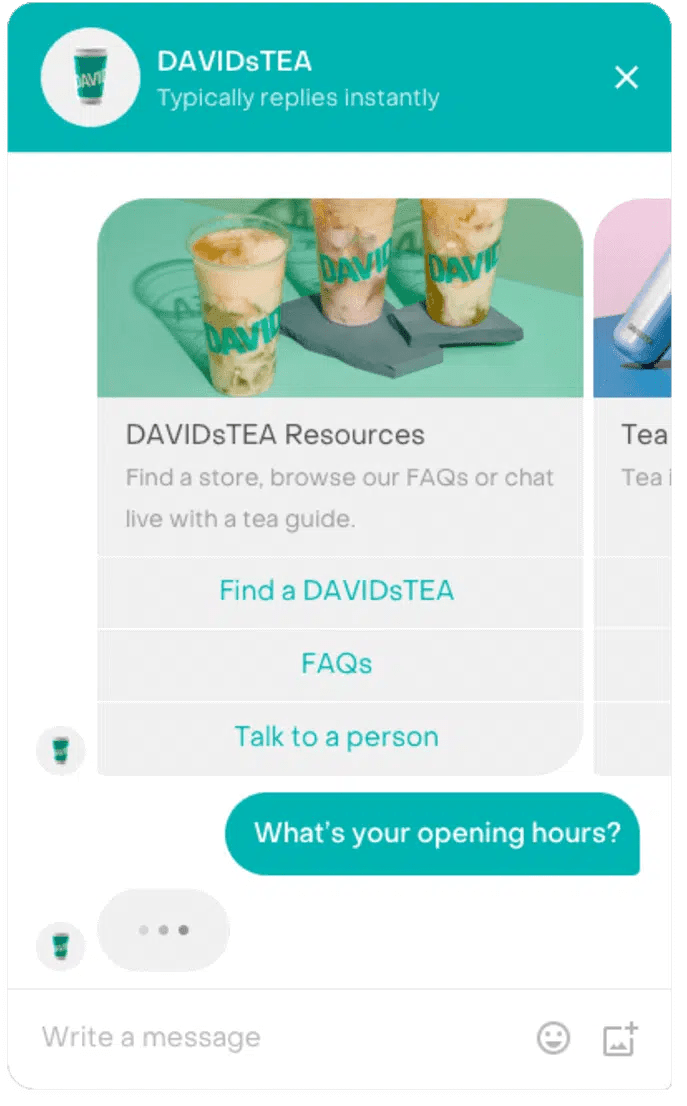
Alt text: David’s Tea customer support chatbot
6. Feedback collection
Automating the testimonial collection process is an excellent way to get honest feedback about your products and social proof for marketing purposes. You can then use that feedback to improve your operations and product.
For instance, The Tea Shelf, a tea retailer, uses a simple WhatsApp automation to contact customers. If it has been over two weeks after you've purchased something from their store, they send a feedback link on your WhatsApp number, encouraging you to fill it out. In some cases, they even offer an upfront discount to incentivize customers.

The Tea Shelf’s WhatsApp chatbot
Source: Tea Shelf
7. Omnichannel marketing/sales
Customers are present on all kinds of platforms these days. There are plenty of options to reach customers. For example, messaging apps like SMS, Slack or Telegram. A chatbot developer could build you an integrated chatbot to reach them on these channels.
You can send offers, product catalogs, and even facilitate purchases through them. Licious, a meat retailer, sends limited-time offers, order updates, or feedback forms through WhatsApp. It offers a low-lift way to engage customers right where they are.

Alt text: Licious’s WhatsApp chatbot
Source: Licious
Pro tip: Hire a chatbot developer to create an integrated ecosystem of ecommerce bots to improve your customer experience.
8. Personalization
Twenty-nine percent of customers are less likely to abandon their carts when you offer a personalized shopping experience. But, offering this at scale is tricky as you need real-time data and the ability to analyze them quickly. This is where ecommerce chatbots come in.
When Albert Varkki, co-founder of Von Baer, a leather goods store, tried to integrate chatbots in his ecommerce store in 2020, it was unsuccessful.
“The chatbots weren't personalized enough to provide real value beyond basic facts. This led us to remove them entirely,” says Varkki. “However, now with the widespread use of large language models (LLMs), we can use this newfound technology to help customers find the products they want without frustrating them, which reduces the time for support staff and increases customer satisfaction.”
Sephora achieved similar results using natural language processing with integrated Kik and Facebook Messenger bots. The bot shows a short quiz and then uses the answers to provide personalized recommendations.
In addition, it also offers educational resources like makeup tips and tutorials with the product to engage customers.

Alt text: Sephora’s virtual assistant and reservation assistant chatbot
Use ecommerce chatbots to improve your business’s bottom line
As a small business owner of an ecommerce platform, you're likely juggling numerous tasks, from inventory management to customer service. Deploying ecommerce bots is an excellent way to:
Reduce support costs
Improve customer satisfaction
Enhance retention rates
Improve operational efficiency
If you need to develop or optimize your chatbots, consider hiring a freelance chatbot developer instead. They can help you figure out the best solution for your business by considering your current and future needs to design a custom bot for your business.
Faizan Khan, public relations and content marketing specialist at Ubuy UK, recommends hiring those who are cost-effective and provide high-quality chatbots.
“Working with freelancers, you can scale up gradually as needed. Hiring remote freelancers eliminates the need for office space and benefits, thereby saving costs,” says Khan. “Also, hire skilled developers who can customize your chatbot based on specific needs to enhance the overall user experience.”
Hire an expert chatbot developer on Fiverr
Want to hire a freelance chatbot developer? Sign up for Fiverr today.

